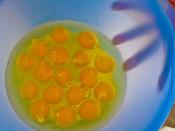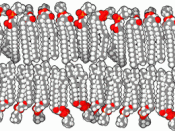Phospholipids serve a very important function in a cell. They form a strong but flexible, selectively permeable membrane around the cell. They hold the contents of the cell inside the cell and keep the outside environment outside the cell while still allowing the cell to exchange needed materials.
The plasma membrane is made of a phospholipid bilayer. The bilayer consists of a double layer of phospholipids. The Fluid Mosaic model was introduced in 1972. This model helps to describe the structure and properties of the cell membrane in a way that is more easily understood. Simply put the cell membrane is two layers of phospholipid molecules that come together due to their unique properties. Phospholipid molecules are constructed like fatty acid molecules (three fatty acid molecules attached to a glycerol molecule), except one of the fatty acid chains is replaced by a phosphate group with an R group attached.
Phospholipids are molecules with a polar hydrophillic head and non-polar hydrophobic tails. This structure means that the membrane forms quickly, is very strong , but also gives it the property of fluidity. The phospholipids are arranged in a bilayer. Their hydrophilic phosphate heads facing outwards and their hydrophobic tails facing in towards the middle of the bilayer. The molecules arrange this way because there is water inside and outside the cell. The hydrophilic water loving heads are attracted to the water. The hydrophobic tails are repelled by the water and face each other in the center of the membrane.
The plasma membrane is flexible. It allows proteins to be imbedded in it. These proteins help regulate what enters and exits a cell. There are several different kinds of proteins each with a specific function. The proteins help molecules to pass in and out of the cell, or bind to the...


